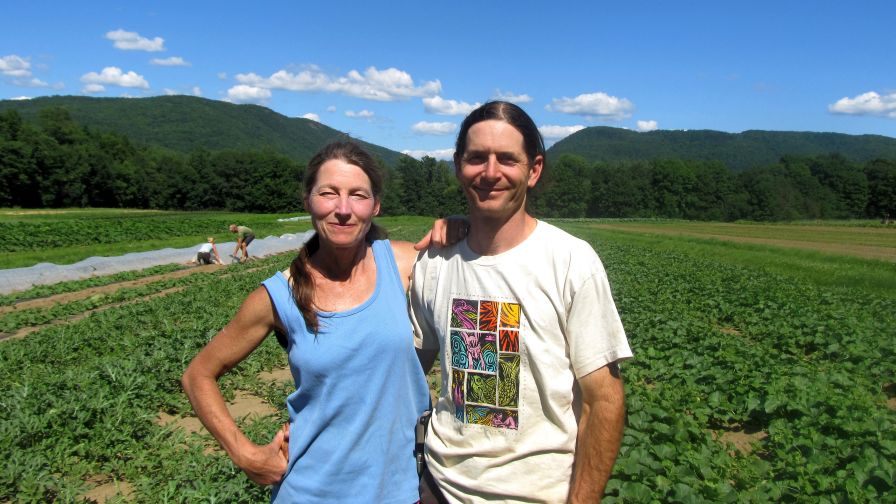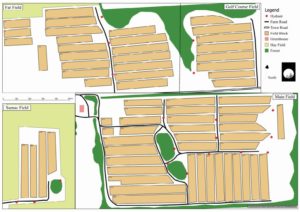The Small Organic Farm Life

Rachel Nevitt and David Zuckerman
Full Moon Farm’s owners, Rachel Nevitt and David Zuckerman, embody many of the stereotypes you may have about Vermont organic growers. They are true believers in caring for the land with sustainable and organic practices. And they are politically liberal — in fact, last November, Zuckerman was elected as Vermont’s first Lieutenant Governor who ran on a Progressive Party ticket (along with the Democratic Party).
Read David Zuckerman’s thoughts about politics and the power he thinks growers have.
But, as is always the case in real life, they are not caricatures. They have worked hard to build the farm that Zuckerman started in 1999, and both studied agriculture, then gained experience laboring on other farms before creating their own.
As their farm has grown, the couple dug into a deep sense of self-reliance mixed with a healthy respect for the support they receive from their peers in order to reach their goals. What they want from their farm — and for life — is to have a way to support their passion for their family life, politics, and sustainability.
That self-reliance is key, despite factors that could undermine it, like Zuckerman’s political career as a state representative, then senator, and now as Lieutenant Governor, and Nevitt’s tick-borne chronic illness.
“One of the things that David and I share, we’re the kind of farmers in the old sense of you figure out what needs to be done, and you get it done without bringing in other people,” Nevitt says.
Self-Reliance Isn’t Enough
Nevitt pays homage to how other growers have created a support network, not only when they need to blow off steam, but in practical matters as well.
“There are a lot of farmers we have become friends with from the Burlington Farmers’ Market,” Nevitt says. “We have a farm dinner, where everyone brings a dish from their farm, hangs out and talks shop.”
The couple have found virtual camaraderie as well, through an old-fashioned listserv.
“It’s a great place for us to throw ideas out or problems to people — like ‘my tomatoes got late blight in the high tunnels,’ and someone will jump in with advice,” she says.
The listserv includes farmers, seed company employees, and the University of Vermont horticulture Plant Diagnostician, Ann Hazelrigg. Nevitt says Hazelrigg is especially valuable. She’ll urge growers to verify their own diagnosis by sending in a sample.
“She’s right to do that. I got something wrong this past winter,” Nevitt says.
Growers on the listserv also post about making bumper crops available to peers, recommend contacts for distributing crops, offer tips on making sausage, suggestions for delivery drop-offs, and review slaughterhouses.
Like any crowd-sourced support, some posts are helpful, and others aren’t.
“Vermont is a very supportive-of-agriculture state,” Nevitt says.
Making the Leap to a Bigger Operation
Today’s version of the farm took years to create.
It started out in 1999 as part of the Intervale Center’s Farm Incubation program in Burlington.
“You lease land, equipment, and a building, and you see if you can farm and run a business for three years,” Nevitt says. “If you can’t, you can run away with no major debt.”
The couple ran a 16-acre farm, with 45 crops and even more cultivars. The next smallest farm in the program was on 2,000 square feet.
In 2009, the couple moved from the incubator site in the city to its current site outside of Burlington.
The farm increased from 16 acres to 155 acres. Only 25 to 30 acres are in production at any given time, with the same amount of acreage laying fallow under cover crops. They also added certified organic livestock — pigs and chickens — to their farm.
That leap in size was an easier transition than you might think.
“There’s a lot of things about farming that are easier on a bigger scale,” Nevitt says. “Once you jump to a bigger scale, you buy things like a carrot harvester.”
That harvester, Nevitt says, made it possible to harvest a half-acre lot in half an hour with fewer employees than it took a larger team two hours to harvest at the incubator site.
 Plotting Production is Like a Jigsaw Puzzle
Plotting Production is Like a Jigsaw Puzzle
There are two main growing areas at Full Moon Farm, one with clay loam soil and one with sandy loam. Each field is subdivided into half acre lots.
Zuckerman originally envisioned being able to cultivate one field for three years while the other revived under a cover crop, then switching fields. He also wanted to carefully plan out how each crop followed another on the same lot.
“In the ideal world, I would have a perfect plan. I know it’s best to follow x crop with y, because I know y uses the nutrients x didn’t use,” he says.
But the difference in drainage between the two fields that weather had more of an impact on which field was planted when.
“If it’s a wet winter, I start on sandy; in a dry summer, I use the loamy. The shifting weather has thrown off my plan to use this field for three years,” Zuckerman says.
That led to a patchwork of which lots are under cultivation in both sections, and which are fallow. And with the wide array of crops grown — more than 50 crops and more than 100 cultivars — Zuckerman and Nevitt needed a system to make sense of the complexity.
Just this past year, Full Moon Farm’s lots were plotted out on a computer and numbered. That allows Zuckerman to direct workers to lots much like servers are assigned tables in a restaurant.
“When you have 10-ish new people every season, most who have not farmed before, the simpler the better,” he says. “Instead of telling them to, ‘Go out to the brassicas, turn left, and go over two lots,’ while they are stuck at thinking over, ‘What does a brassica look like?’ I can now say, ‘Go to block 42.”

Due to differing soil conditions, planned crops end up being shuffled from one field to another.
Although Zuckerman is unable to fulfill his original vision of one large field left fallow, while the other was worked on a well-synchronized schedule, he still is able to achieve much of his original goal.
So what grows in each block changes from year to year. And instead of planting each lot with only one crop, he groups together those that, when planted together, will be harvested in a similar time frame. So carrots and beets will grow together.
Crops like broccoli and lettuce are planted weekly in season. He would like to have each one planted in successive beds to make harvesting easier, but when the weather intervenes, that plan changes.
Another factor that affects how crops are laid out is how well a crop will follow another. Sweet corn stubble is a big challenge for cultivating small-seed crops like lettuce mixes and carrots. So transplanted cucurbits or broccoli will go into those lots.









